Moselle
| Moselle | |
|---|---|
 Typical landscape of Moselle vineyards nearSchweich | |
 Map of the Moselle River watershed | |
| Native name |
|
| Location | |
| Countries | |
| Physical characteristics | |
| Source | |
| • location | Vosges mountains |
| • elevation | 715 m (2,346 ft) |
| Mouth | |
• location | Rhine |
• coordinates | 50°21′58″N7°36′25″E/ 50.36611°N 7.60694°E |
| Length | 546 km (339 mi) |
| Basin size | 28,111 km2(10,854 sq mi) |
| Discharge | |
| • average | 284 m3/s (10,000 cu ft/s) |
| Basin features | |
| Progression | Rhine→North Sea |
 | |



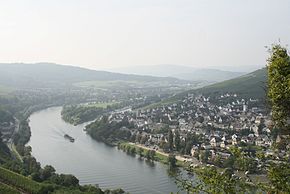


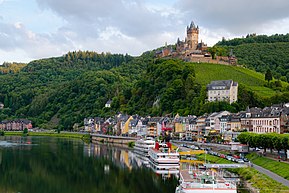
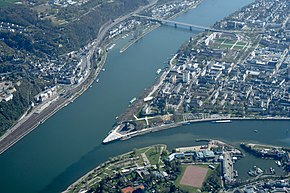
TheMoselle(/moʊˈzɛl/moh-ZEL,[1]French:[mɔzɛl];‹See Tfd›German:Mosel[ˈmoːzl̩];Luxembourgish:Musel[ˈmuzəl]) is ariverthat rises in theVosges mountainsand flows through north-easternFranceandLuxembourgto westernGermany.It is aleft banktributary of theRhine,which it joins atKoblenz.A small part ofBelgiumis in itsbasinas it includes theSauerand theOur.
Its lower course "twists and turns its way betweenTrierand Koblenz along one of Germany's most beautiful river valleys. "[2]In this section the land to the north is theEifelwhich stretches intoBelgium;to the south lies theHunsrück.The river flows through a region that was cultivated by the Romans. Today, its hillsides are covered by terraced vineyards where "some of the bestRieslingsgrow ".[2]Many castle ruins sit on the hilltops above wine villages and towns along the slopes.Traben-Trarbachwith itsart nouveauarchitecture andBernkastel-Kueswith its traditional market square are two of the many tourist attractions on the Moselle river.
Name
[edit]The name Moselle is derived from theCelticname form,Mosela,via theLatinMosella,a diminutive form ofMosa,the Latin description of theMeuse,which used to flow parallel to the Moselle. So theMosellawas the "Little Meuse".
The Moselle is first recorded byTacitusin Book 13 of hisAnnals[3]and in Book 4 of hisHistories.[4]
TheRomanpoetAusoniusmade it a literary theme as early as the 4th century. In his poem dated 371, calledMosella,which was published in 483hexameters,this poet of theLate Antiquityand teacher at the Trier Imperial Court (Kaiserhof) described a journey from Bingen over theHunsrückhills to the Moselle and then following its course to Trier on the road named after him, the Via Ausonia. Ausonius describes flourishing and rich landscapes along the river and in the valley of the Moselle, thanks to the policies of their Roman rulers.
The river subsequently gave its name to two French republicandépartements:MoselleandMeurthe-et-Moselle.
Geography
[edit]
The source of the Moselle is at 715 m (2,346 ft) above sea level on the Col deBussangon the western slopes of theBallon d'Alsacein theVosges.After 544 km (338 mi) it discharges into theRhineat theDeutsches EckinKoblenzat a height of 59 m (194 ft) aboveNHNsea level. The length of the river in France is 313 km (194 mi),[5]for 39 km (24 mi) it forms the border between Germany and Luxembourg, and 208 km (129 mi) is solely within Germany.
The Moselle flows through theLorraineregion, west of the Vosges. Further downstream, in Germany, theMoselle valleyforms the division between theEifelandHunsrückmountain regions.
The average flow rate of the Moselle at its mouth is 328 m3/s (11,600 cu ft/s),[6]making it the second largest tributary of the Rhine by volume after theAare(560 m3/s; 20,000 cu ft/s) and bigger than theMainandNeckar.[7]
River sections
[edit]The section of the Moselle from theFrance–Germany–LuxembourgtripointnearSchengento its confluence with theSaarnearKonzshortly beforeTrieris in Germany known (geographically incorrectly[citation needed]) as theUpper Moselle.The section from Trier toPünderichis theMiddle Moselle,the section between Pünderich and its mouth in Koblenz as theLower Moselleor Terraced Moselle (Terrassenmosel). Characteristic of the Middle and Lower Moselle are its widemeanderscut deeply into the highlands of theRhenish Massif,the most striking of which is theCochemer KrampenbetweenBremmandCochem.Also typical are its vineyard terraces.
From the tripoint the Moselle marks the entire Saarland–Luxembourg border.
Catchment
[edit]Thecatchment areaof the Moselle is 28,286 km2(10,921 sq mi) in area. The French part covers 15,360 km2(5,930 sq mi), about 54 percent of the entire catchment. The German state ofRhineland-Palatinatehas 6,980 km2(2,690 sq mi), theSaarland2,569 km2(992 sq mi), Luxembourg 2,521 km2(973 sq mi),Walloniain Belgium 767 km2(296 sq mi) andNorth Rhine-Westphalia,88 km2(34 sq mi).
Tributaries
[edit]The three largesttributariesof the Moselle are, in alphabetical order, theMeurthe,theSaarand theSauer.The Meurthe was the old upper course of the Moselle, until the lattercapturedthe former upper reaches of theMeuseand took it over. However, the Meuse only delivered a little more water than the Meurthe at its confluence. The Saar is the biggest of all the tributaries (78.2 m3/s; 2,760 cu ft/s) as well as the longest (246 km; 153 mi). The Sauer is the largest left-hand tributary and drains the region on either side of the German-Luxembourg border. The largest tributary relative to the Moselle at its confluence is theMoselotte,which is about 40% greater by volumetric flow and thus represents the main branch of the Moselle system. At its mouth, the Moselle delivers 328 m3/s (11,600 cu ft/s) of water into the Rhine after flowing for 544 km (338 mi).



List of tributaries
[edit]- From the left
Madon, Terrouin, Esch, Rupt de Mad, Orne, Fensch, Gander, Syre, Sauer, Kyll, Salm, Lieser, Alf, Endert, Brohlbach, Elz.
- From the right
Moselotte, Vologne, Meurthe, Seille, Saar, Olewiger Bach, Avelsbach, Ruwer, Feller Bach, Dhron, Ahringsbach, Kautenbach, Lützbach, Flaumbach, Altlayer Bach, Baybach, Ehrbach.
Towns
[edit]Towns along the Moselle are:
- in France:Épinal,Toul,Pont-à-Mousson,MetzandThionville
- in Luxembourg:Schengen,Remich,GrevenmacherandWasserbillig
- in Germany:Konz,Trier,Schweich,Bernkastel-Kues,Traben-Trarbach,Zell,CochemandKoblenz
Adjacent mountain ranges
[edit]From Trier downstream the Moselle separates the twoCentral Uplandranges of theEifel(to the northwest) and theHunsrück(to the southeast).
Geology
[edit]TheVosges,the present source region of the Moselle, were formed about 50 million years ago. In theMioceneandPlioceneepochs the ancient Moselle (Urmosel) was already a tributary of theancient Rhine(Ur-Rhein). When, in theQuaternaryperiod, theRhenish Massifslowly rose, the meanders of the Moselle were formed between theTrierValley and theNeuwied Basin.
Water levels
[edit]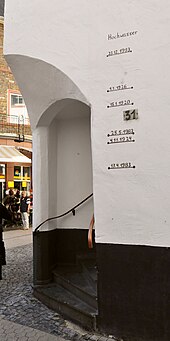
Thehighest navigable water level(HSW) is 6.95 m (22 ft 10 in) and normal level (NSt) is 2.00 m (6 ft 7 in) at the Trier Gauge (Pegel Trier).
- 11.28 m (37 ft 0 in), Trier Gauge on 21 December 1993
- 10.56 m (34 ft 8 in), Trier Gauge on 28 May 1983
- 10.33 m (33 ft 11 in), Trier Gauge on 23 January 1995
- 10.26 m (33 ft 8 in), Trier Gauge on 12 April 1983
- 9.92 m (32 ft 7 in), Trier Gauge on 27 February 1997
- 0.47 m (1 ft 7 in) in Bernkastel on 28 July 1921
History
[edit]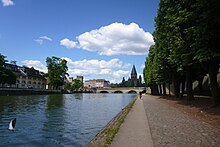
The Moselle was known to the Romans by the name ofFlumen Musalla(in theTabula Peutingeriana), and the river was romanticised by the poetAusoniusaround 371. From 1815, the Moselle formed the border between theGrand Duchy of LuxembourgandPrussia(German Empirein 1871).
DuringWorld War IIthe Moselle was a barrier as the Allies advanced toward Berlin. In September 1944, the American Third Army in France mounted a drive to cross the Moselle atDieulouardand split the German forces. Under the orders of Major General Manton S. Eddy, the80th InfantryDivision was given the objective of establishing a bridgehead that would allow Combat Command A (CCA) of the4th Armored Divisionto advance into the rear of German forces and encircle the city of Nancy.
On September 13, 1944, the 80th Division launched their assault accompanied by extensive artillery and air support, which helped to suppress the German defenses. The division managed to establish a foothold on the east bank of the river, securing a bridgehead at Dieulouard.
With the bridgehead secured, Combat Command A of the 4th Armored Division crossed the Moselle and advanced towards Nancy, encircling the city and cutting off German supply lines. The 80th Division continued its advance, pushing towards the northeast and engaging in fierce combat with German forces.
The operations to capture Nancy continued until September 15 when the city was liberated by the combined efforts of the 80th Infantry Division and the 4th Armored Division. The successful crossing of the Moselle River and the capture of Nancy dealt a significant blow to German defenses in northeastern France and further contributed to the Allied advance towards Germany.[8]
In the act of 10 April 1952 ratifying the treaty instituted by theECSC,Article 2 charged theFrench Government"to initiate, before the establishment of theCommon Market,negotiations with the governments concerned in order to achieve a rapid implementation of the canalisation of the Moselle betweenThionvilleandKoblenz.[9][10][11]
The River was canalised betweenMetzandThionville,via a canal opened in 1964 by the Grand Duchess,Charlotte of Luxembourg,the Federal Chancellor of Germany,Konrad Adenauerand their host,Charles de Gaulle,President of France.[12]
It is on the Moselle, at the site of the France–Germany–Luxembourg tripoint, that theSchengen Agreementwas signed in 1985, leading to the abolishment of border controls within theSchengen Area.
Economy
[edit]The Moselle valley between Metz and Thionville is an industrial area, withcoalmining andsteelmanufacturers.
The Moselle valley is famous for its scenery and wine. Most well-known is the GermanMosel wine region,while the Luxembourgwinegrowingregion is calledMoselle Luxembourgeoiseand the French region is calledAOCMoselle.Most notable among the wines produced here areRiesling,Elbling,Müller-Thurgau,Kerner,andAuxerrois.The German part of the Moselle is a tourist destination.
Navigation
[edit]After the Second World War, France pressed to be able to ply the Moselle with larger ships in order to be able to link the industrial regions ofLorraine.When, in 1955, the population on the Saar voted to belong to West Germany, France demanded as "compensation" an upgrade of the Moselle. On 27 October 1956 they concluded the Moselle Treaty with Germany and Luxembourg for a canalisation of the Moselle and conceded to Germany in return the extension of theGrand Canal d'Alsaceon theUpper Rhineinstead of an extension of the canal via Breisach. In 1958 work began and by 26 May 1964 the Moselle could be officially opened from Metz to Koblenz as a major waterway for shipping with 14locks.France extended it by 1979 as far asNeuves-Maisons.With that, 394 km (245 mi) of the Moselle have been upgraded with a total of 28 locks. In the years 1992 to 1999 the navigable channel was deepened from 2.7 m (8 ft 10 in) to 3.0 m (9 ft 10 in), which enables 1,500-tonne freighters to use the river, a 20% increase in capacity. The channel has a width of 40 m (130 ft), more on the bends. TheMoselle Commission,founded in 1962 with its head office in Trier, is responsible for navigation. The Moselle Shipping Police Act which it has produced is valid in all three participant states from Metz to Koblenz.
In 1921 the Moselle (Mo) became aReichwaterway,[13]today it is a federal waterway (Bundeswasserstraße)[14]fromApachat the tripoint to its mouth on the Rhine at kilometre point 592.29[15]in Koblenz. The waterway is 242 km (150 mi)[15]long and managed by the Trier and Koblenz Water and Shipping Offices (Wasser- und Schifffahrtsämtern Trier und Koblenz). It is categorized as a Europeanwaterwayof Class Vb. Its kilometrage begins at its mouth at kilometre point 0 and runs upstream. Since 1816 it has formed a 36 km (22 mi) long[15]condominium from Apach, a common Germany–Luxembourg sovereign area with a division of responsibilities set out in a 1976 agreement. The International Moselle Company, initially set up in 1957 to finance the construction of the river's upgrade, manages the shipping charges and the operation and maintenance of the waterway which they are used to fund.
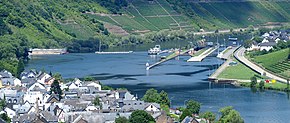
Today the Moselle is navigable for largecargo shipsup to 110 metres (360 ft) long[16]from the Rhine in Koblenz up toNeuves-Maisons,south of Nancy. For smaller ships it is connected to other parts of France through theCanal de la Meuseand theCanal de la Marne au Rhin.There arelocksinKoblenz,Lehmen,Müden,Fankel,Sankt Aldegund,Enkirch,Zeltingen,Wintrich,Detzem,Trier,Grevenmacher,Palzem,[16]Apach,Kœnigsmacker,Thionville,Richemont,Talange,Metz,Ars-sur-Moselle,Pagny-sur-Moselle,Blénod-lès-Pont-à-Mousson,Custines,Pompey,Aingeray,Fontenoy-sur-Moselle,Toul,Villey-le-Sec,and Neuves-Maisons.[17]
By 1970 more than 10 million tonnes of goods were being transported on the Moselle, the majority on towed barges. Upstream freight mainly comprised fuel and ores; downstream the main goods were steel products, gravel and rocks. There is aninland portatTrier,atransshipment siteinZell (Mosel);and there are other ports inMertert,Thionville,MetzandFrouard.In addition to freighters there are also pleasure boats for tourists between the very busy wine villages and small towns of the Middle and Lower Moselle. There are alsoyachtingor sports marinas in the following places:Koblenz,Winningen,Brodenbach,Burgen,Löf,Hatzenport,Senheim,Treis,Traben-Trarbach,Kues,Neumagen,Pölich,Schweich,TrierandKonz.The Moselle is linked near Toul via theCanal de la Marne au Rhinwithinter aliatheMeuse,theSaôneand theRhône.Other canals link the river to theNorth Seaand even theMediterranean.
Locks and dams (weirs)
[edit]
There is a total of 28changes of levelon the Moselle:
- 16 in France nearNeuves-Maisons,Villey-le-Sec,Toul,Fontenoy-sur-Moselle,Aingeray,Frouard-Pompey,Custines,Blénod-lès-Pont-à-Mousson,Pagny-sur-Moselle,Ars-sur-Moselle,Metz,Talange,Richemont,Thionville,KœnigsmackerandApach
- 2 between Luxembourg and Germany nearStadtbredimus-PalzemandGrevenmacher-Wellen
- 10 in Germany nearTrier,Detzem,Wintrich,Zeltingen,Enkirch,St. Aldegund,Fankel,Müden,LehmenandKoblenz.Detzemis the highest lock – 9 m (30 ft) – and at 29 km (18 mi) the upstream reach is the longest on the river; it is the only lock to be built on a canal of some length excavated outside the river bed.
With the exception of Detzem, all the structures at each change in level are laid-out side by side; thelockis by one riverbank, theweirin the middle and thehydropower planton the other bank. Between the lock and weir are a boat slipway and channel and boat lock, while between the weir and the power station is thefish ladder.The structures have been blended into the landscape through their low-level design; this was achieved by the choice of sector gates for the weir, vertically lowering upper gates and mitred lower lock gates. The water levels and hydropower works are controlled by the Fankel Central Control Station (Zentralwarte Fankel) of the RWE Power Company atFankel.
Tourism
[edit]
Through the Moselle valley run the Moselle Wine Route and the Moselle Cycleway, which may be cycled fromMetzinFranceviaTriertoKoblenzon theRiver Rhine,a distance of 311 km (193 mi).

Between Koblenz and Trier, large sections run on thetrackbedof the old Moselle Valley Railway, far from the noise and fumes of motor vehicles. Every year on the Sunday afterPentecost,the 140 km (87 mi) of road betweenSchweichandCochemis also car-free as part of Happy Moselle Day.
A number of notable castles and ruins adorn the heights above the Moselle valley and many are visible on a boat trip on the Moselle.
In 1910, a hiking trail, the Moselle Ridgeway, was established which runs for 185 km (115 mi) on the Eifel side and 262 km (163 mi) on the Hunsrück side. Another unusual trail runs fromEdiger-Ellervia theCalmont TrailtoBremmthrough the steepest vineyard in Europe.
Before the construction of barrages the Moselle was a popular route forfolding kayakswhich is why many of the weirs have boat channels. The river is still used today bycanoeists,especially during the annual week-long lock closures when no commercial shipping is permitted.
In April 2014 theMoselle Trailwas opened, a path running for 365 km (227 mi) from Perl on theUpper MoselletoKoblenz.Numerous Moselle Trail "partner trails", the so-called side branches (Seitensprünge) and "dream paths" (Traumpfade) enhance the hiking network in the Moselle Valley.[18]
TheADAC'sRallye Deutschlandhas taken place since 2000 in the vineyards along the Moselle atVeldenz,Dhron,Piesport,Minheim,Kesten,Trittenheim,Fell,RuwertalandTrier.
AtKoblenz LockstheMosellumoffers exhibitions about the migration of fish in the Moselle as well as water ecology, navigation and power generation. With the construction of the visitor and information centre the most modernfish ladderalong the Moselle was opened.
Wine
[edit]
TheMoselle winegrowing regionlies along the Moselle with a cultivated area of about 10,540 ha (26,000 acres). The largest part, currently just under 9,000 ha (22,000 acres), is on German soil in the states ofRhineland-PalatinateandSaarland;the Luxembourg part has an area of about 1,300 ha (3,200 acres) (seeWine in Luxembourg). Upstream on the Moselle the vineyards extend into France as far asSeillein the region ofCôtes de Mosellewith an area of 130 ha (320 acres) and to the region aroundToul(Côtes de Toul) covering 110 ha (270 acres).
The German Moselle wine region, including its tributaries, bears the growing and manufacturing name of "Mosel". For marketing reasons the agricultural authorities of the region have divided it into six winegrowing areas.[19]The wine literature and specialist press, by contrast, divide the region into four areas based on geomorphological, micro-climatic and also historical reasons:
- Upper Moselle
- The valley sides of theUpper Moselle(also called the Burgundy Moselle,Burgundermosel) with their overwhelminglymuschelkalksoils belong geologically to the so-calledParis Basin,which explains its low proportion ofRiesling– only around 10% in 2010 – and the increasing cultivation ofPinot BlancandPinot Noirgrapes.
- Trier Region
- Around the city ofTrierand in the valleys of theSaarandRuwerwith their side valleys, the Riesling is the predominant grape on the shale soils, with over 80% of the crop. One climatic feature of this area is the frequent orientation of often small southwest-southeast facing locations in which the vegetation is exposed to stronger, cooler winds and, especially in the light of recent global warming, often achieve lower degrees of maturity than in the narrow, often deeply incised valley of theMiddleandLower Moselle.[20]
- Middle Moselle
- With around 6,000 ha (15,000 acres) of vineyard theMiddle Moselleis the largest winegrowing area of the Moselle. According to the wine experts and trade, the "greatest" wines of the Moselle, both in quantity and quality, are grown here on land that has been consolidated into large concerns with much vaunted steeply sloped vineyards.[21]
- Lower Moselle
- In theLower MoselleValley, there are a number of medieval castles, high above little villages, decorated withtimber-framed houses,surrounded by steep slopes with small terraces in the narrow, winding valley. Here, cultivating vines is very labour-intensive and costly and it is difficult to make it economical. As a result, it is common for vineyards to fall into ruin here.
The wine industry on the German Moselle has been declining for decades. In 2005, statistics showed there were 10,375 ha (25,640 acres) of vineyard; by 2012 this had fallen to just 8,491 ha (20,980 acres).[22]The vineyards that have fallen fallow are mostly those on extremely steep hillsides. There has been a major decline in the number of so-calledNebenerwerbswinzer(vintners for whom it is a secondary occupation), and the small, family farming operations that, until the end of the 1960s formed the majority of wine businesses. Comparative figures by the Chamber of Agriculture for Rhineland-Palatinate for several wine villages on the Lower Moselle show that there were still 797 wine businesses in the early 1960s, but by the early 2000s there were only just under 100.
There has been the opposite trend amongst the established traditional wine estates and more recent vintners with a sound education inoenologyand business management, who have increased their business through the reclamation of once renowned, but long forgotten sites. The end of the 20th century saw the rediscovery of the use of specialterroir[23]in order to improve quality and value, which has led to a more nuanced view of Moselle wine that, a few years before, had been characterised by overproduction, label scandals and cheap offers.
Moselle umbrella brand
[edit]On 10 November 2006 inBurg,the Moselle Regional Initiative was founded. The introduction of the Moselle as anumbrella brandwas based on that of theEifelregion and covers products and services from the areas of agriculture, forestry, tourism, handicrafts and nature.
Moselle slate
[edit]Moselle slate (Moselschiefer) is a manufacturing and trade description forslatefrom the municipalities ofMayen,Polch,Müllenbach,Trierand its surrounding area. Today only products from the roofing slate mines ofKatzenbergin Mayen andMargaretain Polch bear the name Moselle Slate. The name is derived from the historical transport route for this slate along the Moselle to theLower Rhine.
Railways
[edit]The following railway lines run or ran along the river:
- Koblenz–Trier railway(Moselstrecke), between Koblenz and Bullay, and in Trier, mostly on the left (northern) bank
- Pünderich–Traben-Trarbach railway,for its entire length, on the left (northern) bank
- Moselle Railway,between Bullay and Trier, on the right (southern) bank. Closed in the 1960s.
- Trier West Railway,between Ehrang and Igel, on the left (northern) bank
- Thionville–Trier railway(Obermoselstrecke), for its entire length, on the right (eastern) bank
- CFL line 1a,between Wasserbillig and Grevenmacher, on the left (western) bank. No passenger service remains.
- Metz–Luxembourg railway,between Thionville and Metz, mainly on the left bank
- Lérouville–Metz railway, between Metz and Novéant, mainly on the left bank
- Frouard–Novéant railway, mainly on the left bank
- Paris–Strasbourg railway,between Frouard and Toul
- Blainville-Damelevières–Lure railway, between Bayon and Épinal
- Épinal–Bussang railway,betweenÉpinalandRemiremont,on the left bank
Literature
[edit]- Mosella,aLatin poembyAusonius(4th century).
- In the tale, "The Seven Swabians"of theBrothers Grimm,these Swabians drown trying to cross the Moselle.
- Accounts of the river, its folklore and local history appear inSmall Boat on the Mosellea 1968 book byRoger Pilkington.
Castles
[edit]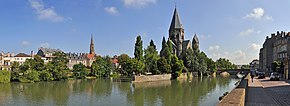
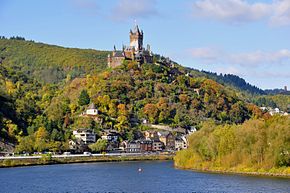

- Château de Meinsberg(dit de Malbrouck): nearManderen,this castle was built in the 15th century but rebuilt in the 1990s. Today it is used for numerous cultural events.
- Château Fort de Sierck-les-Bains:situated just on the French-German border atSierck-les-Bains,this fortress of theDuke of Lorrainedates back to the 11th century. Most of today's castle was constructed in the 18th century, following plans fromVauban.
- Schloss Berg: aRenaissancecastle atNennig,today a hotel and acasino.
- Alte Burg:amanor housebuilt in 1360 atLonguich.One of the few surviving manor houses in rural Rhineland-Palatinate.
- Schloss Lieser:a palace atLieserbuilt from 1884 to 1887 inhistoristic style.
- Landshut Castle:a castle built by theElectorate of Trierin the 13th century atBernkastel-Kues.
- Grevenburg:ruins of a castle atTraben-Trarbachbuilt byJohann III of Sponheim-Starkenburgabout 1350, destroyed, after many sieges, in 1734.
- Marienburg: a 12th-century castle and latermonasterynearPünderichandAlf.
- Arras Castle:a 12th-century castle inAlf.
- Metternich Castle:a castle built around 1120 atBeilstein,today partly in ruins.
- Cochem Castle:The castle inCochemwas originally built in the 11th century, but was completely destroyed byFrenchsoldiers in 1689. The present castle was rebuilt later in the 19th century.
- Thurant Castle:Above the town ofAlkenis Thurant Castle, built in the 13th century. It is the only twin-toweredcastlealong the Moselle. The fortress was built by the Count Palatine Henry of the house of Guelph between 1198 and 1206. From 1246 to 1248, it was the two archbishops of Cologne and Trier. Following conquest, it was divided by a partition wall into two halves, each with a keep (tower). During the 19th century, Thurant disintegrated, becoming a ruin; and in 1911 was acquired by Privy Councilor, Dr. Robert Allmers, who had it rebuilt. Since 1973, the castle has been owned by the Allmers and Wulf families.[24]
- Ehrenburg:a 12th-century castle built by theElectorate of TrieratBrodenbach.
- Eltz Castle:The von Eltz family castle, whose history dates back to the 12th century. It remains in private hands to this day but it is open to visitors.
- Lower and Upper Castle,Kobern-Gondorf:two 11th-century castles, today mostly in ruins.
- Pyrmont Castle:This 13th-century castle nearRoeswas remodelled and extended several times during theBaroqueera.
- Bischofstein Castle:Across the river from the municipality ofBurgenis this 13th-century castle, which was destroyed during theNine Years' War,but was reconstructed and now serves as a retreat centre for the Fichte Gymnasium inKrefeld.
References
[edit]- ^"Moselle".The American Heritage Dictionary of the English Language(5th ed.). HarperCollins.Retrieved2019-10-01.
- ^abMoselle: Holidays in one of Germany's most beautiful river valleysat www.romantic-germany.info. Retrieved 23 Jan 2016.
- ^Publius Cornelius Tacitus: Der Text ist verfügbar in der lateinischen Wikisource:Kapitel LIII,at la.wikisource.org
- ^Publius Cornelius Tacitus: Der Text ist verfügbar in der lateinischen Wikisource; erwähnt ist die Mosel inKapitel 71undKapitel 77,at la.wikisource.org
- ^Sandre."Fiche cours d'eau - La Moselle (A---0060)".Retrieved9 June2022.
- ^Hydrologischer Atlas der Schweiz 2002, Tab. 5.4Natürliche Abflüsse 1961-1980(natural discharges) (see mapArchived2011-07-07 at theWayback Machine)
- ^TheMeuse,with a volumetric discharge of 350 m3/s (12,000 cu ft/s) is not considered, since it has not officially been a tributary of the Rhine since 1970 (although it is hydrologically).
- ^"American Drive to the Moselle".
- ^L'historique de la canalisation de la Moselle,par M. René Bour. pp.101 à 112
- ^Levainville Jacques, La canalisation de la Moselle.In:Annales de Géographie.1928, t. 37, no. 206. pp. 180–184.
- ^"Rivière Moselle – Dictionnaire des canaux et rivières de France".Retrieved3 May2016.
- ^Institut National de l’Audiovisuel – Ina.fr."La canalisation de la Moselle".Ina.fr.Retrieved3 May2016.
- ^Verzeichnis A, Lfd. Nr. 39 der ChronikArchived2016-07-22 at theWayback Machine,Wasser- und Schifffahrtsverwaltung des Bundes, at wsv.de
- ^Verzeichnis E, Lfd. Nr. 34 der ChronikArchived2016-07-22 at theWayback Machine,Wasser- und Schifffahrtsverwaltung des Bundes, at wsv.de
- ^abcGliederung BundeswasserstraßenArchived2016-01-21 at theWayback Machine,mit Informationen u. a. zu Längen (in km) der Hauptschifffahrtswege (Hauptstrecken und bestimmte Nebenstrecken) der Binnenwasserstraßen des Bundes, bei der Wasser- und Schifffahrtsverwaltung des Bundes, at wsv.de
- ^ab"Elwis database"(PDF).Archived fromthe original(PDF)on 2010-10-28.Retrieved2010-03-17.
- ^"DTNE: Direction territoriale Nord-Est VNF".Retrieved3 May2016.
- ^Moselsteig entfacht das Wanderfieber.In: Trierischer Volksfreund, dated 26 September 2014. Retrieved 26 September 2014, at volksfreund.de
- ^Von der Mehrzahl der Winzer nicht genutzte Herkunftsbezeichnung
- ^Stuart Pigott, Chandra Kurt, Manfred Lüer:Stuart Pigotts Weinreisen – Mosel.Scherz, Frankfurt am Main, 2009,ISBN978-3-502-15173-9,pp. 103 ff.
- ^Daniel Deckers (Hg.),Zur Lage des deutschen Weins – Spitzenlagen und Spitzenweine,Stuttgart 2003,ISBN978-3-608-94073-2pp. 137–187
- ^Publications by the Statistical Office of Rhineland-Palatinate.
- ^Reinhard Löwenstein,Vom Öchsle zum Terroir,Frankfurter Allgemeine newspaper No. 232, 7 October 2003 andDie Zukunft liegt im Terroir,in the same paper dated 17 December 2005
- ^"Burg Thurant – Wenn Sie etwas Besonderes suchen".thurant.de.
Bibliography
[edit]- Decimius Magnus Ausonius:Mosella [Description of a journey by ship on the Moselle around 371 A. D.]http://www.perseus.tufts.edu/hopper/text?doc=Perseus:text:2008.01.0619
- Jakob Hölscher (ed.):Das Moselthal von Trier bis Coblenz. In malerischen Ansichten, nach der Natur gezeichnet von C. Bodmer, in acqua tinta geätzt von R. Bodmer.30 pages. Koblenz, 1831–1833
- Johann August Klein:Moselthal zwischen Koblenz und Konz,printed by Heriot, Coblenz, 1831
- Johann August Klein:Das Moselthal zwischen Koblenz und Zell mit Städten, Ortschaften, Ritterburgen, historisch, topographisch, malerisch.Heriot, Koblenz, 1831
- Wilhelm Haag:Ausonius und seine Mosella.Gaertner, Berlin, 1900
- Michael Gerhard:Die Mosel, dargestellt in ihrem Lauf, ihrer Entstehung und ihrer Bedeutung für den Menschen.Prüm, 1910.Online edition dilibri Rhineland-Palatinate
- Carl Hauptmann:Die Mosel von Cochem bis Bernkastel.Bonn 1910.Online edition dilibri Rhineland-Palatinate
- Carl Hauptmann:Die Mosel von Coblenz bis Cochem in Wanderbildern.Bonn, 1911.Online edition dilibri Rhineland-Palatinate
- Ludwig Mathar:Die Mosel (Die Rheinlande, Bilder von Land, Volk und Kunst, Zweiter Band: Die Mosel)Cologne o. J. (around 1925), 607 S. (with 117 illustrations and a map of the Moselle Valley from Trier to Coblenz)
- Rudolf G. Binding:Moselfahrt aus Liebeskummer – Novelle einer Landschaft,Frankfurt am Main, 1933 (51.–75. Tausend)
- Josef Adolf Schmoll alias Eisenwerth:Die Mosel von der Quelle bis zum Rhein(Deutsche Lande – Deutsche Kunst). 2nd edition, Munich/Berlin, 1972
- Willy Leson (ed.):Romantische Reise durch das Moseltal-Von Koblenz nach Trier (with graphics by Carl Bodmer and text by Johann August Klein and Christian von Stramberg),Cologne, 1978
- Heinz Cüppers, Gérard Collot, Alfons Kolling, Gérard Thill (Red.):Die Römer an Mosel und Saar (Zeugnisse der Römerzeit in Lothringen, in Luxemburg, im Raum Trier und im Saarland),Mainz, 1983, Zabern: 2nd revised edition (with 46 colour and 346 black and white photographs)
- Heinz Held:Die Mosel von der Mündung bei Koblenz bis zur Quelle in den Vogesen: Landschaft, Kultur, Geschichte(DuMont-Kunst-Reiseführer). 3rd edition, Cologne, 1989
- Jean-Claude Bonnefont, Hubert Collin (dir.),Meurthe-et-Moselle,edition Bonneton, Paris, 1996, 318 pages.ISBN2-86253-203-7
- M. Eckoldt (ed.), Flüsse und Kanäle, Die Geschichte der deutschen Wasserstraßen, DSV-Verlag, 1998
- Ulrich Nonn:Eine Moselreise im 4. Jahrhundert-Decimus Magnus Ausonius und seine "Mosella".In: Koblenzer Beiträge zur Geschichte und Kultur, Vol. 8, Koblenz: Görres-Verlag 2000, pp. 8–24 (with map and illustrations)
- Reinhold Schommers:Die Mosel(DuMont-Reise-Taschenbücher). DuMont, Ostfildern 2001,ISBN3-7701-3741-8
- Ludwin Vogel:Deutschland, Frankreich und die Mosel. Europäische Integrationspolitik in den Montan-Regionen Ruhr, Lothringen, Luxemburg und der Saar.Klartext, Essen, 2001,ISBN3-89861-003-9
- Decimius Magnus Ausonius:Mosella. Lateinisch-deutsch.Published, translated and commented on by Paul Dräger. Tusculum Studienausgaben. Artemis und Winkler, Düsseldorf, 2004,ISBN3-7608-1380-1
- Uwe Anhäuser:Die Ausoniusstraße. Ein archäologischer Reise- und Wanderführer.Rhein-Mosel, Alf/Mosel, 2006,ISBN3-89801-032-5
- Karl-Josef Gilles:Das Moseltal zwischen Koblenz und Trier 1920 bis 1950(series of archive photographs), Sutton, Erfurt, 2006,ISBN978-3-89702-943-9.
- Wasser- und Schifffahrtsdirektion Südwest: Kompendium der Wasser- und Schifffahrtsdirektion Südwest. Organisatorische und technische Daten, Binnenschifffahrt, Aufgaben, Wasserstraßen. self-publication, Mainz, June 2007
- Alexander Thon / Stefan Ulrich:Von den Schauern der Vorwelt umweht... Burgen und Schlösser an der Mosel.Schnell + Steiner, Regensburg 2007, 1st edition, 180 pp. numerous photographs, 2 overview maps of the Moselle
- Wolfgang Lambrecht:Malerische Mosel – Gemälde und Druckgraphik aus 100 Jahren,[Farbbroschüre mit Werken u. a. von Carl Bodmer, Clarkson Stanfield, Rowbotham, Compton, Wolfsberger, Benekkenstein, Burger, Thoma, Nonn, Möhren, Zysing und Bayer, published by the Sparkasse Mittelmosel and the Lions-Förderverein Cochem], Cochem, 2007
- Karl-Josef Schäfer und Wolfgang Welter:Ein Jakobsweg von Koblenz-Stolzenfels nach Trier. Der Pilgerwanderführer für den Mosel-Camino.Books on Demand, Norderstedt, 2009 (2nd updated edition)ISBN978-3-8334-9888-6
- Xavier Deru:Die Römer an Maas und Mosel,Zabern-Verlag, Mainz, 2010
- Groben, Josef:Mosella. Historisch-kulturelle Monographie,Trier, 2011, 311 pp., 237 photographs.
- Stefan Barme:Nacktarsch, Viez und Ledertanga – Ausflüge in die Kulturgeschichte des Mosellandes.Stephan Moll Verlag, 2012 (1st edition)ISBN978-3-940760-37-1
- Joachim Gruber: Decimus Magnus Ausonius, "Mosella"Kritische Ausgabe, Übersetzung, Kommentar.Walter de Gruyter, Berlin. Series: Texts and commentaries, Vol. 42, 2013, XI, 370 pp.
External links
[edit]- mosel.de,mosel.de
- Die Mosel,die-mosel.de
- Moseltal,moseltal.de
- www.mosel.com,mosel.com
- HoloGuides – Moselle,hologuides.com
- River Moselleguide to the French section; maps and information on places, ports and moorings on the river from Neuves-Maisons to Apach, by the author ofInland Waterways of France,Imray
- Navigation details for 80 French rivers and canals(French waterways website section)
- Bibliography on Water Resources and International LawPeace Palace Library at ppl.nl
- Livecam Moselle river,webcam.cochem.c
- German-Luxembourgish-French Mosel Agency(in German/French)
- German Waterways Agency Trier (Wasser- und Schifffahrtsamt Trier)(in German)
- Moselle
- Rivers of Luxembourg
- Rivers of Rhineland-Palatinate
- Rivers of Saarland
- Rivers of France
- Grevenmacher
- Remich
- Moselle basin
- Germany–Luxembourg border
- International rivers of Europe
- Federal waterways in Germany
- Rivers of Grand Est
- Rivers of Vosges (department)
- Rivers of Meurthe-et-Moselle
- Rivers of Moselle (department)
- Rivers of Germany
- Border rivers

